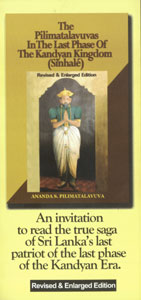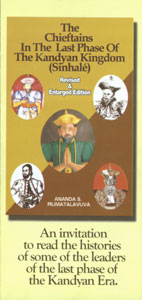Reading these two fascinating, and unusual, books I came to admire Ananda Pilimatavuva (AP) for restoring the reputation of his great, and much maligned forebear, the great Maha Adikaram in the court of Sri Vikrama Rajasinha, the last King of Sinhale. I have always believed that some of the best, and most readable, writings on history have been by gifted ‘amateurs’ rather than by professional historians. Writers such as AP, often bring to bear a strong personal conviction which they espouse with their own reinterpretation of historical facts, either ignored or misinterpreted by earlier, more ‘objective’, writers.
In the Ceylon History we studied in Kandy’s Dharmaraja College, many decades ago in Colonial Ceylon, Pilimatalavuva stood out as an unmitigated schemer who tried to sell his country to the British and met with the traitor’s death he fully deserved. As descendants of the Pilimatalavuva clan it was only natural that the family never believed this generally accepted version. However, they had to bide their time till AP, in retirement from tea planting, took it upon himself to immerse himself in old records and oral histories to redeem his ancestor’s reputation. He has done so in grand style. “The Pilima Talvuvas” is, clearly, a labour of love — but not of blind and prejudiced loyalty. His was a wise decision to paint a wider canvas within which to place the Maha Adikaram so that the reader could appreciate the origins of the conflicting loyalties that motivated this aristocrat.
 |
 |
AP begins his narrative by tracing the unusual origins of this family which throw light on a rarely (at all) studied aspect of Sinhala history. This is the close connection that the later kingdoms of Sinhale have had with South India. While there is ample evidence of such cultural interaction during the Kotte kingdom, there is little written about continuing links that the Kandyan court had with South India.
Wimaladharma Suriya’s son Prince Vijayapala married into a South Indian ‘royal’ family. So did Narendra Sinha, the last king of Sinhala blood, thus opening the floodgates for the Nayakkar dynasty, fated to be our last. What is lesser known is the quiet influx ( seepage may be a better term) of South Indian elites into the bloodline of Kandyan aristocracy. To quote AP they came “in search of office and position under their protectors the Nayakkar kings.
They married into the leading radala families and became naturalized as Sinhala Kandyan. Ananda’s family history attributes their origin to a ‘prince’ Sumedha from Tanjore who came to Sri Lanka, pledged allegiance to the Nayakkar king and was rewarded with a radala bride and much land. Alas, no record exists how the South Indian conversed with his bride. Presumably, this nouveau Kandyan seems to have acquired extraordinary linguistic skills because he was rapidly appointed to the important posts of Ma Vasala Lekam and Maha Gabada Nilame in the Royal Court. A further point of interest is the ease with which these Nayakkars and their entourage slipped through the ‘cordon sanitaire’ that the Dutch and British cutting the Kandyan Kingdom from the coastal regions.
These two books cast light on the Byzantine intrigues that characterized the court of Sri Vikrama Rajasinha. Initially various nobles were jostling each other for power and influence over the young king. Chief among them was Pilima Talavuva who placed him on the throne as a puppet. But, before long, the puppet freed himself of these strings and firmly placed his own hand on the tiller of State. Pilima Talavuva though descended, just a few decades earlier, from a South Indian ancestor, now began his intrigues against the king claiming the throne should rightfully belong to a full blooded Sinhala king.
Thus began the intrigues with various British agents to oust Sri Vikrama and transform the Kingdom of Sinhale into a British Protectorate with a friendly noble as ruler — though not as ‘king’. Pilima Talavuva was only too aware of the deep divisions and envy that characterized the Kandyan Court and would have stood in his tortuous march to the throne. Sri Vikrama was his equal in stratagems and guile. He played the nobles one against another by changing their responsibilities and grandiose titles and ‘transferring’ them to distant regions (punitive ploy yet in vogue). AP gives us a blow-by-blow account of Pilima Talavuva’s dealings with the British and the tight-rope walking he did with Sri Vikrama. But the devious monarch decided to end this ‘treachery’ — not by arbitrary ‘diktat’ but after a trial by a panel of judges drawn from Pilima Talavuva’s fellow nobles. He was found guilty and sentenced to death. On being led to his execution he haughtily declined the King’s pardon if he renounced treason and fearlessly knelt before the executioner’s sword.
However, the intrigues never ceased and Ehelepola Disava assumed the role of prime intriguer against the King. He fled to the British in Colombo when he was about to meet Pilima Talavuva’s fate, abandoning his family to the death that traditional law decreed for the families of traitors. Ehelepola masterminded the capture of his former king and also the Convention of 1815 by which his fellow nobles signed over to the British the Kingdom of Sinhale. Interestingly, some of the signatures placed to this document are in Grantha illustrating how very deeply Nayakkar influence had penetrated the Kandyan Court. Ehelepola was never destined to enjoy the fruits of his treason that the cunning British had promised him. He was exiled to Mauritius and a lonely death.
The first book gives us detailed genealogical details of the Pilima Talavuva family, their dynastic alliances, the high positions they held and the lands granted them by Royal decree. AP’s diligent ferreting out of little known documents and oral histories from elders of the clan adds luster to his narrative. The second book follows the same pattern when he describes a number of other significant nobles such as Keppitipola, Madugalle and Lewke. In writing of these he also writes of the ill-fated, but heroic, rebellion of 1818 defeated, once again, by the perfidy of some fellow chieftains.
One of the most fascinating figures in the last phase of the Sinhala kingdom also flits through these pages. This is Vilbave the mysterious Pretender to the throne who boldly crowned himself King to the acclamation of the nobles and multitude. Though some nobles may have doubted his proclaimed legitimacy, it is possible that they felt the people needed a King as the rallying point. But the man clearly possessed the charisma and the know how to carry off the role. Both his emergence and his disappearance remain shrouded in mystery, as he was never captured with the other rebels.
Both books are well illustrated and we are brought face to face with the last remnants of Kandyan nobility, their mansions and the grace and beauty of old Kandy and its monuments. Among the many sketches here one that grabbed my interest is the little sittara narrative where stiff stylized figures enact the execution of Ehelepola Kumarihamy and family.
Fine volumes for the general reader interested in the decline and fall of Sinhale. |



